11 Herbal Teas For Dermatitis
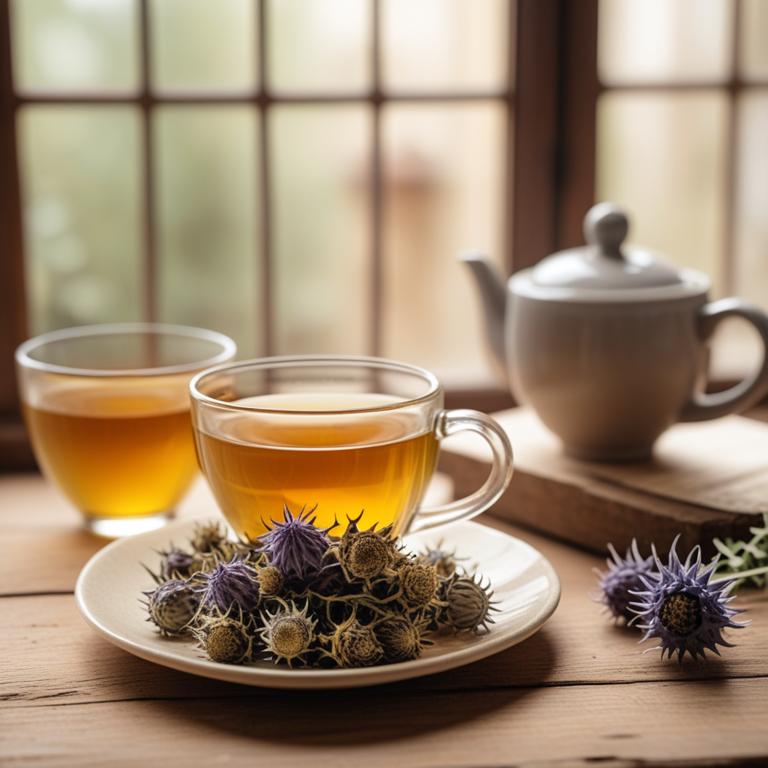
Herbal teas have been used for centuries to soothe and calm skin conditions like dermatitis.
These teas work by reducing inflammation and calming the skin. For example, Urtica dioica, or nettle leaf tea, has anti-inflammatory properties that help to calm itchy and irritated skin. Melissa officinalis, or lemon balm tea, has a calming effect on the nervous system, which can help to reduce stress and anxiety that can trigger dermatitis.
Calendula officinalis, or marigold tea, has anti-inflammatory and antimicrobial properties that help to soothe and heal the skin. Drinking these teas can bring many benefits to your life. It can help to reduce the frequency and severity of dermatitis outbreaks, and make your skin feel softer and more comfortable. The teas are also easy to make and can be enjoyed hot or cold, making them a convenient addition to your daily routine.
By incorporating these teas into your daily routine, you can find relief from the discomfort and distress of dermatitis.
- 1. Urtica dioica
- 2. Melissa officinalis
- 3. Calendula officinalis
- 4. Echinacea purpurea
- 5. Symphytum officinale
- 6. Hypericum perforatum
- 7. Aloe barbadensis
- 8. Equisetum arvense
- 9. Taraxacum officinale
- 10. Glycyrrhiza glabra
- 11. Silybum marianum
1. Urtica dioica
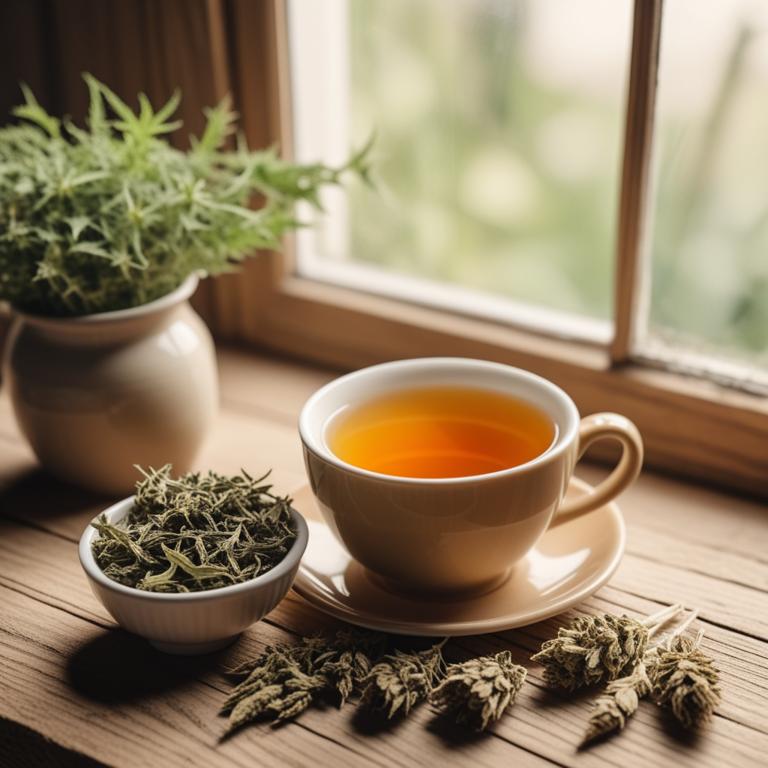
Urtica dioica teas contains bioactive compounds like quercetin, kaempferol, and isorhapontigenin that help alleviate dermatitis symptoms.
These compounds have anti-inflammatory and antioxidant properties, which reduce skin inflammation and protect it from damage. The tea's high levels of flavonoids and phenolic acids also help to soothe and calm irritated skin, reducing redness and itchiness. Quercetin, in particular, has been shown to inhibit the production of histamine, a chemical that contributes to dermatitis symptoms.
By reducing inflammation and protecting the skin, Urtica dioica teas can help alleviate the discomfort associated with dermatitis.
- Gather 1 cup of fresh Urtica dioica leaves, or 1 tablespoon of dried leaves.
- Bring 1 cup of water to a boil in a pot.
- Add the Urtica dioica leaves to the boiling water and reduce heat.
- Steep for 5-10 minutes, then strain the liquid into a cup.
- Drink 1-2 cups of the tea, 2-3 times a day, to help with dermatitis symptoms.
2. Melissa officinalis

Melissa officinalis teas contains rosmarinic acid, luteolin, and apigenin as its bioactive constituents.
These compounds have anti-inflammatory and antioxidant properties, which help soothe and calm irritated skin. The rosmarinic acid in Melissa officinalis teas reduces redness and swelling associated with dermatitis, while its antioxidant properties protect the skin from damage caused by free radicals. Luteolin and apigenin also have anti-inflammatory effects, which help to reduce inflammation and promote healing in the skin.
By reducing inflammation and protecting the skin, Melissa officinalis teas can provide relief from the symptoms of dermatitis.
- Gather 1 cup of fresh Melissa officinalis leaves or 1 teaspoon of dried leaves.
- Heat 1 cup of water in a pot and bring it to a boil.
- Reduce heat and add the Melissa officinalis leaves. Let it steep for 5-7 minutes.
- Strain the tea using a fine-mesh sieve or cheesecloth. Discard the solids.
- Drink 1 cup of the tea 2-3 times a day to help soothe dermatitis symptoms.
3. Calendula officinalis

Calendula officinalis teas contains triterpenoids, flavonoids, and carotenoids as its active constituents.
These compounds have anti-inflammatory and antioxidant properties, which help to soothe and calm irritated skin. The triterpenoids, particularly silymarin, reduce inflammation and promote healing by inhibiting the production of pro-inflammatory enzymes. The flavonoids, including quercetin, also have anti-inflammatory effects and help to protect the skin from damage caused by free radicals.
By reducing inflammation and promoting healing, Calendula officinalis teas can help to alleviate symptoms of dermatitis, such as redness and itching.
- Gather 1 tablespoon of dried Calendula officinalis flowers and a tea infuser or a small piece of cheesecloth.
- Heat 1 cup of water in a pot until it reaches boiling point.
- Remove the pot from heat and add the Calendula flowers to the water. Let it steep for 5-7 minutes.
- Strain the tea into a cup using the tea infuser or cheesecloth. Discard the solids.
- Drink the tea 2-3 times a day for relief from dermatitis symptoms. Store any leftover tea in the refrigerator for up to 24 hours.
4. Echinacea purpurea

Echinacea purpurea teas contains alkylamides, caffeic acid derivatives, and volatile oils that give it anti-inflammatory properties.
These properties help reduce redness and swelling associated with dermatitis. The tea's ability to inhibit the production of pro-inflammatory cytokines and enzymes also makes it effective in alleviating dermatitis symptoms. The flavonoids present in Echinacea purpurea tea, such as kaempferol and quercetin, have antioxidant properties that help protect the skin from damage caused by free radicals.
By reducing inflammation and protecting the skin, Echinacea purpurea tea can help soothe and calm dermatitis-affected skin.
- Gather 2 teaspoons of dried Echinacea purpurea root and flowers.
- Heat 1 cup of water in a pot until it starts boiling.
- Add the Echinacea purpurea root and flowers to the boiling water.
- Reduce heat and let it simmer for 5-7 minutes.
- Strain the tea and let it cool before drinking 1-2 cups a day.
5. Symphytum officinale
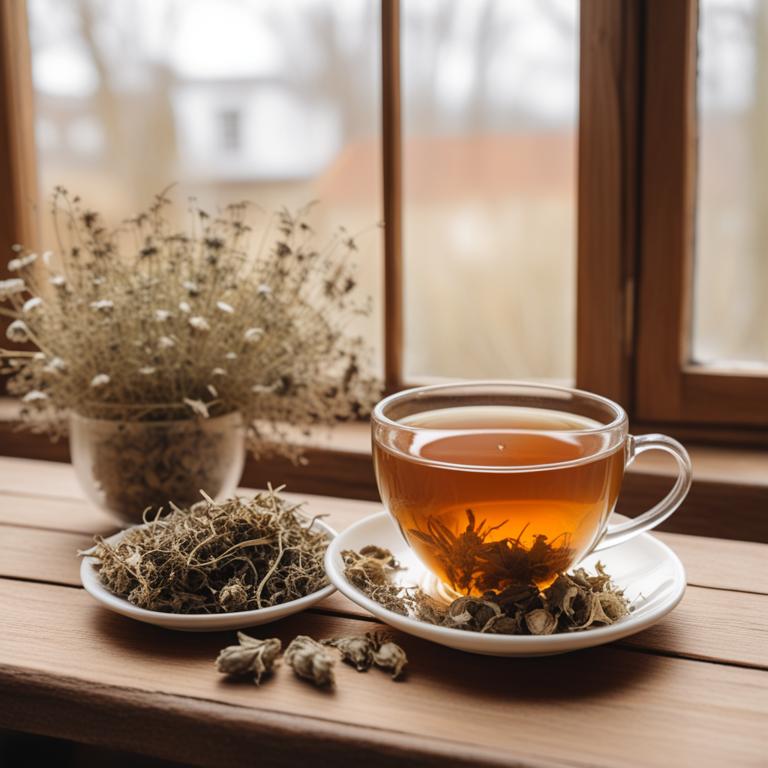
Symphytum officinale teas contains active constituents like allantoin, rosmarinic acid, and phenolic acids.
Allantoin has anti-inflammatory and soothing properties that help to reduce redness and itching in the skin. Rosmarinic acid has antioxidant properties that help to protect the skin from damage and promote healing. Phenolic acids also have anti-inflammatory properties that help to reduce swelling and pain.
These properties make Symphytum officinale teas a good choice for people with dermatitis, as it may help to calm and soothe the skin, reducing symptoms of inflammation and irritation.
- Gather 1 cup of fresh or dried Symphytum officinale leaves, 1 cup of boiling water, and a tea strainer.
- Measure 1 tablespoon of honey (optional) and have it ready.
- Pour boiling water over the Symphytum officinale leaves in the tea strainer.
- Steep for 5-7 minutes, then carefully lift the tea strainer out of the cup.
- Add honey to taste, if desired, and drink the tea 2-3 times a day for relief from dermatitis symptoms.
6. Hypericum perforatum
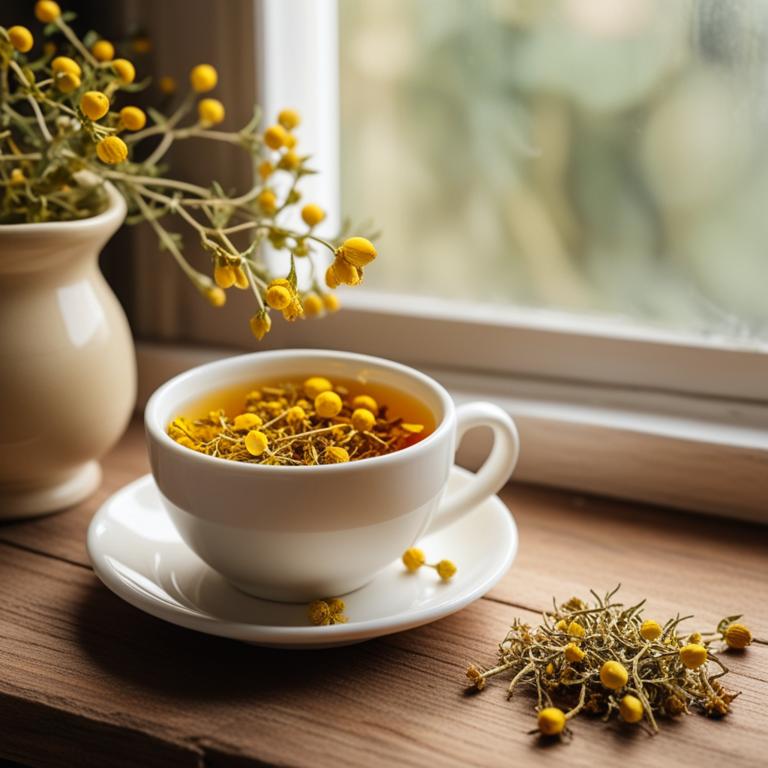
Hypericum perforatum teas contains flavonoids, such as quercetin, and phenolic acids, including hyperoside and rutin.
These compounds have anti-inflammatory properties that help reduce redness and swelling associated with dermatitis. The tea also contains naphthoquinones like hypericin and emodin, which have antioxidant properties that protect the skin from damage and promote healing. The anti-inflammatory and antioxidant properties of Hypericum perforatum tea may help to soothe and calm irritated skin, reducing the severity of dermatitis symptoms.
Regular consumption of this tea may help to promote skin health and reduce the frequency and severity of dermatitis outbreaks.
- Gather 1 tablespoon of dried Hypericum perforatum flowers and 1 cup of boiling water.
- Steep the dried Hypericum perforatum flowers in the boiling water for 5-7 minutes.
- Strain the mixture into a cup to remove the flowers.
- Add honey or lemon to taste, if desired. The recommended dosage is 1/2 cup of tea, 2-3 times a day.
- Store any leftover tea in the refrigerator for up to 24 hours. Consult a doctor before using Hypericum perforatum for dermatitis treatment.
7. Aloe barbadensis
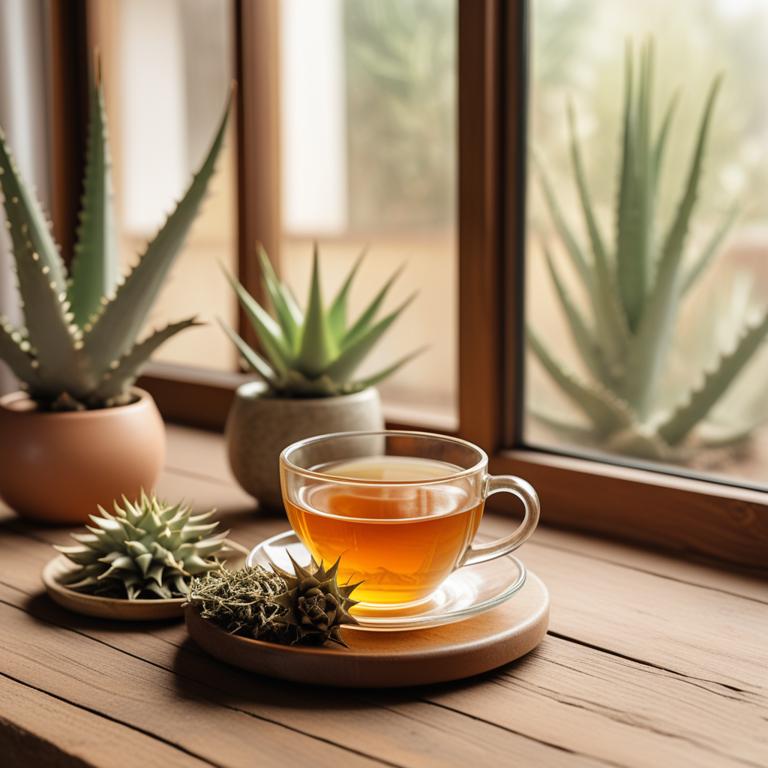
Aloe barbadensis teas contains several bioactive constituents that are beneficial for skin health, particularly for individuals suffering from dermatitis.
The main components responsible for its therapeutic effects are aloin, aloe-emodin, and acemannan. Aloin has anti-inflammatory properties that help reduce redness and swelling associated with dermatitis, while aloe-emodin has antibacterial properties that combat infections that can exacerbate the condition. Acemannan, on the other hand, has soothing and moisturizing properties that help calm and hydrate the skin, promoting healing and reducing discomfort.
By incorporating these bioactive compounds, Aloe barbadensis teas can provide relief from the symptoms of dermatitis and promote healthy skin regeneration.
- Gather 1 cup of fresh Aloe barbadensis gel and 1 cup of boiling water.
- Measure 2 tablespoons of honey and 1 tablespoon of lemon juice.
- Combine the Aloe gel and boiling water in a bowl, stir well.
- Add the honey and lemon juice to the Aloe mixture, stir until the honey dissolves.
- Drink the Aloe tea 2-3 times a day to help soothe dermatitis symptoms.
8. Equisetum arvense
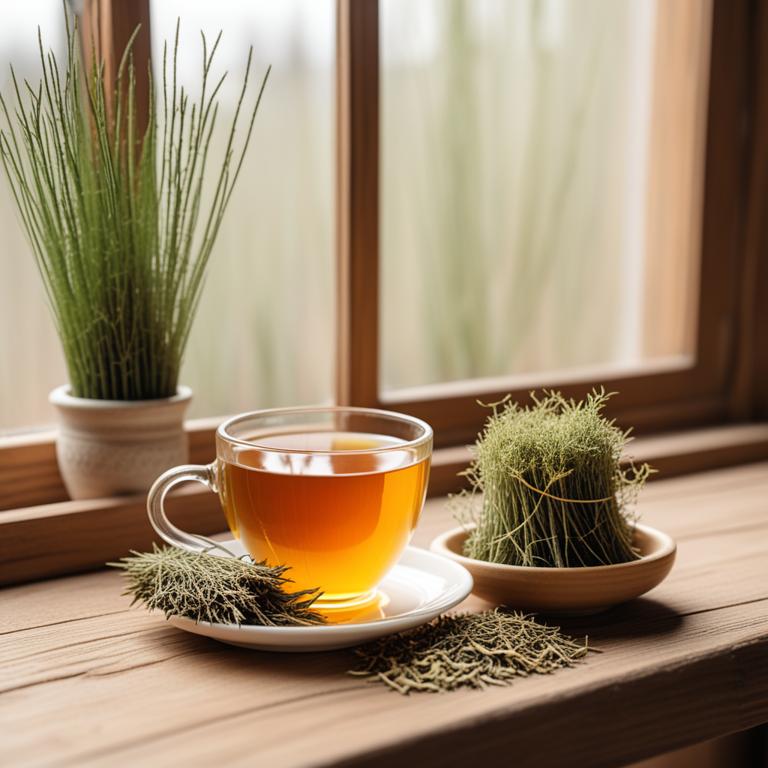
Equisetum arvense teas contains a number of bioactive compounds, including saponins, flavonoids, and polysaccharides.
These compounds have anti-inflammatory and soothing properties, which can help to reduce the symptoms of dermatitis. The saponins in the tea are particularly effective at calming irritated skin and reducing redness, while the flavonoids have antioxidant properties that can help to protect the skin from damage. The polysaccharides in the tea have been shown to stimulate the production of ceramides, which help to repair and maintain the skin's natural barrier function.
By using Equisetum arvense teas as a treatment for dermatitis, individuals may be able to reduce their symptoms and promote healing.
- Gather 1 cup of fresh or dried Equisetum arvense (horsetail) roots and stems.
- Combine 1 cup of the horsetail roots and stems with 4 cups of water in a saucepan.
- Bring the mixture to a boil, then reduce the heat and let it simmer for 10-15 minutes.
- Strain the mixture into a cup or teapot to remove the horsetail solids.
- Drink 1 cup of the tea 2-3 times a day for relief from dermatitis symptoms.
9. Taraxacum officinale
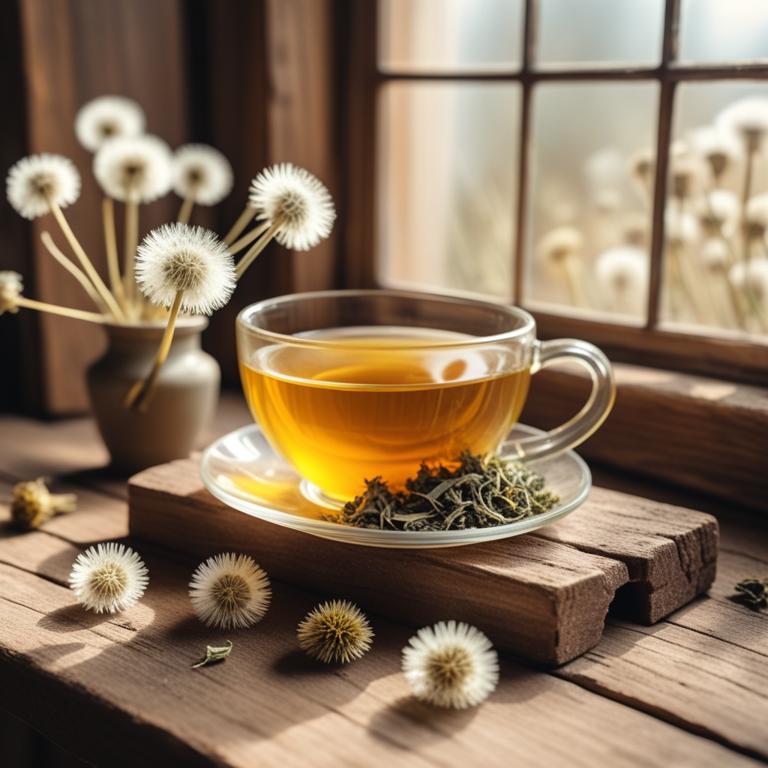
Taraxacum officinale teas contains bioactive constituents like flavonoids, phenolic acids, and terpenoids.
These compounds have anti-inflammatory properties, which help reduce redness and swelling in the skin associated with dermatitis. Taraxacum officinale also has antioxidant properties, which help protect the skin from damage caused by free radicals. The tea's saponins and sesquiterpenes have been shown to have immunomodulatory effects, which can help regulate the immune system's response and reduce inflammation.
The combination of these properties makes Taraxacum officinale teas a potential natural remedy for managing dermatitis symptoms.
- Gather 1 cup of fresh Taraxacum officinale leaves and flowers.
- Combine the Taraxacum officinale leaves and flowers in a tea infuser or a heat-resistant cup.
- Pour 8 oz of boiling water over the Taraxacum officinale leaves and flowers.
- Steep the mixture for 5-7 minutes, then strain the liquid.
- Drink 1-2 cups of the Taraxacum officinale tea, 2-3 times a day, for dermatitis relief.
10. Glycyrrhiza glabra

Glycyrrhiza glabra teas contains glycyrrhizin and flavonoids, which have anti-inflammatory properties that help soothe skin irritations.
The anti-inflammatory effect is due to the inhibition of the enzyme 5-lipoxygenase, which reduces the production of leukotrienes that contribute to inflammation. Glycyrrhizin also has a direct effect on the skin, reducing the production of pro-inflammatory cytokines that exacerbate dermatitis. The flavonoids present in the tea have antioxidant properties that help protect the skin from damage caused by free radicals, further reducing inflammation and promoting healing.
By reducing inflammation and promoting healing, Glycyrrhiza glabra teas can help alleviate the symptoms of dermatitis.
- Gather 1 cup of fresh or dried Glycyrrhiza glabra roots.
- Crush the roots into small pieces using a mortar and pestle or a coffee grinder.
- Steep 1 tablespoon of the crushed roots in 1 cup of boiling water for 5-7 minutes.
- Strain the mixture using a fine-mesh sieve or cheesecloth into a cup.
- Drink the tea 2-3 times a day for relief from dermatitis symptoms.
11. Silybum marianum

Silybum marianum teas contains silymarin, a group of bioactive constituents that have anti-inflammatory and antioxidant properties.
These properties help to reduce inflammation and protect the skin from damage caused by free radicals, which can contribute to dermatitis. Silymarin also has immunomodulatory effects, meaning it can help regulate the immune system's response to allergens and irritants. The flavonoids and polyphenols present in silymarin tea have been shown to have a soothing effect on the skin, reducing redness and itching associated with dermatitis.
By reducing inflammation and promoting skin health, Silybum marianum teas may help to alleviate symptoms of dermatitis.
- Gather 1 cup of dried Silybum marianum flowers and leaves.
- Add 1 tablespoon of the dried flowers and leaves to a heat-resistant cup.
- Pour 1 cup of boiling water over the Silybum marianum mixture.
- Steep the mixture for 5-10 minutes, then strain it using a fine-mesh sieve.
- Drink the tea 2-3 times a day, as needed, to help with dermatitis symptoms.